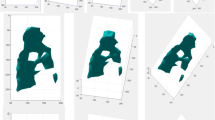Abstract
This paper is dedicated to modifying some steps needed to generate a dense 3D-reconstruction from a video stream. Since critical motions are common in the majority of practical situations, care was taken in our work to deal with some of these motions and “stitch” projective reconstructions from different coordinate systems. Moreover, the demand for real-time-near results in these applications is huge, so the system must be able to carry out a high-quality reconstruction in the shortest time. Finally, a new calibration algorithm will be presented and a hint will be given how a fast dense reconstruction can be obtained.
Similar content being viewed by others
References
S. Bougnoux, “From Projective to Euclidean Space Under Any Practical Situation, a Criticism of Self-Calibration,” in Proceedings of the International Conference on Computer Vision (ICCV) (Bombay, India, January 1998), pp. 790–796.
C. G. Harris and M. J. Stevens, “A Combined Corner and Edge Detector,” in Proceedings of 4th Alvey Vision Conference, 1998, pp. 147–151.
R. Hartley and A. Zisserman, Multiple View Geometry in Computer Vision (Cambridge University Press, Cambridge, 2000).
B. Lucas and T. Kanade, “An Iterative Image Registration Technique with an Application to Stereo Vision,” in Proceedings of 7th International Joint Conference on Artificial Intelligence (IJCAI), 1981, pp. 674–679.
D. Martinec and T. Pajdla, “3D Reconstruction by Gluing Pair-Wise Euclidean Reconstructions, or How to Achieve a Good Reconstruction from Bad Images,” in Proceedings of the 3D Data Processing, Visualization and Transmission Conference (3DPVT) (University of North Carolina, Chapel Hill, USA, June 2006).
J. Matas, and O. Chum, “Randomized Ransac with T d, d-test,” Image and Vision Computing 22(10), 837–842 (2004).
J. Matas, O. Chum, and T. Werner, “Two-View Geometry Estimation Unaffected by a Dominant Plane,” in Proceedings of Conference on Computer Vision and Pattern Recognition (CVPR) (Los Alamitos, California, USA, June 2005), vol. 1, pp. 772–780.
D. Morris and T. Kanade, “Image-Consistent Surface Triangulation,” in Proceedings of the IEEE Conference on Computer Vision and Pattern Recognition (CVPR-00) (Los Alamitos, 2000. IEEE), vol. 1, pp. 332–338.
D. Nistér, “Automatic Dense Reconstruction from Uncalibrated Video Sequences,” PhD Thesis (Royal Institute of Technology KTH, Stockholm, Sweden, 2001).
D. Nistér, “Untwisting a Projective Reconstruction” International Journal of Computer Vision 60(2), 165–183.
M. Pollefeys, Obtaining 3D Models with a Hand-Held Camera/3D Modeling from Images, Course/Tutorial Notes, Presented at Siggraph 2002/2001/2000, 3DIM 2001/2003, ECCV 2000, http://www.cs.unc.edu/marc/tutorial/.
M. Pollefeys, F. Verbiest, and L. Van Gool, “Surviving Dominant Planes in Uncalibrated Structure and Motion Recovery,” in Proceeding in Computer Vision—ECCV 2002, 7th European Conference on Computer Vision (Lecture Notes in Computer Science, 2003), vol. 2351, pp. 837–851.
Author information
Authors and Affiliations
Corresponding author
Additional information
The text was submitted by the author in English.
Dimitri Bulatov, born in 1978 in Moscow, Russia, graduated in 2004 in mathematics at the University of Würzburg, Germany. Since 2005, he has worked as a scientific assistant in the department of Scene Analysis of the Research Institute of Optronic and Pattern Recognition in Ettlingen, near Karlsruhe. His main areas of research include structure-from-motion, camera calibration, and dense reconstruction algorithms.
Rights and permissions
About this article
Cite this article
Bulatov, D. Metric reconstruction from video sequences. Pattern Recognit. Image Anal. 18, 300–308 (2008). https://doi.org/10.1134/S1054661808020168
Received:
Published:
Issue Date:
DOI: https://doi.org/10.1134/S1054661808020168




